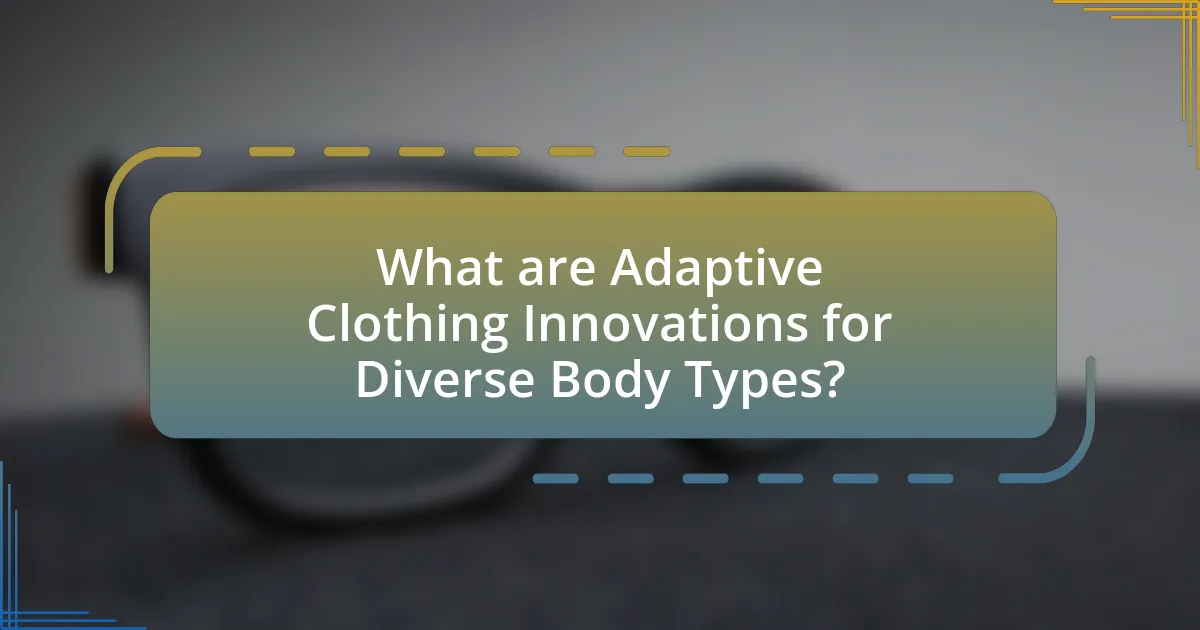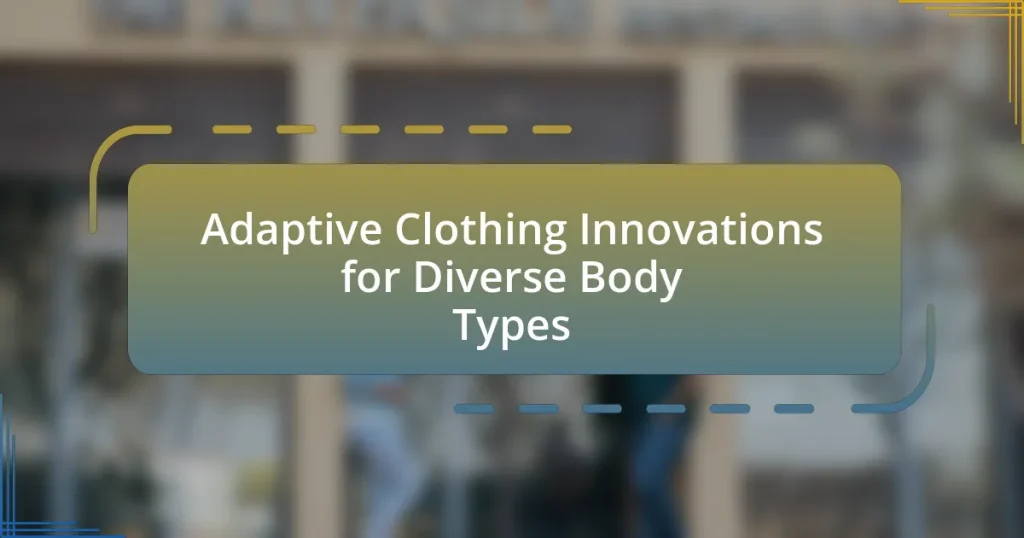Adaptive clothing innovations for diverse body types focus on enhancing comfort and accessibility for individuals with disabilities, seniors, and those with unique body shapes. Key features include adjustable sizing, magnetic closures, and stretchable fabrics, which cater to various physical needs and preferences. Brands like Tommy Hilfiger and Zappos are leading the way in this inclusive fashion movement, addressing the practical challenges faced by approximately 1 in 5 people in the U.S. living with disabilities. The article explores how these innovations promote self-expression, improve quality of life, and the challenges designers face in creating functional yet stylish adaptive clothing. Additionally, it highlights the importance of consumer feedback and collaboration in the design process, as well as the latest trends and technological advancements shaping the future of adaptive apparel.

What are Adaptive Clothing Innovations for Diverse Body Types?
Adaptive clothing innovations for diverse body types include features such as adjustable sizing, magnetic closures, and stretchable fabrics designed to accommodate various physical needs and preferences. These innovations aim to enhance comfort and accessibility for individuals with disabilities, seniors, and those with unique body shapes. For instance, brands like Tommy Hilfiger and Zappos have introduced lines that incorporate these elements, demonstrating a growing recognition of the need for inclusivity in fashion. Research indicates that approximately 1 in 5 people in the U.S. live with a disability, highlighting the importance of adaptive clothing solutions that cater to this demographic.
How do adaptive clothing innovations cater to different body types?
Adaptive clothing innovations cater to different body types by incorporating adjustable features, diverse sizing options, and specialized designs that accommodate various physical needs. These innovations include elements such as elastic waistbands, magnetic closures, and stretchable fabrics, which enhance comfort and ease of wear for individuals with disabilities or unique body shapes. For instance, brands like Tommy Hilfiger and Zappos have developed lines specifically designed for wheelchair users, featuring seated-friendly cuts and adaptive fastenings. This approach not only promotes inclusivity but also addresses the practical challenges faced by individuals with different body types, ensuring that clothing is functional and stylish.
What specific features make clothing adaptive for diverse body types?
Clothing is adaptive for diverse body types through features such as adjustable sizing, stretchable fabrics, and inclusive design elements. Adjustable sizing allows garments to accommodate various body shapes and sizes, ensuring a better fit for individuals with different proportions. Stretchable fabrics, like spandex blends, provide flexibility and comfort, adapting to movements and body changes. Inclusive design elements, such as wrap styles, side openings, and magnetic closures, enhance accessibility and ease of wear for individuals with mobility challenges. These features collectively ensure that clothing can meet the needs of a wide range of body types, promoting comfort and functionality.
How do these features enhance comfort and functionality?
Adaptive clothing innovations enhance comfort and functionality by incorporating features such as adjustable sizing, breathable fabrics, and easy closures. These elements allow garments to accommodate various body shapes and mobility needs, ensuring a better fit and ease of wear. For instance, adjustable sizing can adapt to changes in body dimensions, which is particularly beneficial for individuals with fluctuating body types or disabilities. Breathable fabrics improve airflow and moisture-wicking, contributing to overall comfort during wear. Easy closures, such as magnetic buttons or Velcro, facilitate independent dressing for those with limited dexterity. These features collectively improve the user experience, making clothing more accessible and practical for diverse body types.
Why is adaptive clothing important for inclusivity?
Adaptive clothing is important for inclusivity because it provides functional and stylish options for individuals with disabilities or specific needs, allowing them to participate fully in society. This type of clothing is designed to accommodate various physical challenges, such as limited mobility or sensory sensitivities, ensuring that all individuals can express their personal style and feel comfortable. Research indicates that inclusive fashion can significantly enhance the quality of life for people with disabilities, promoting independence and self-esteem. For instance, a study published in the Journal of Fashion Marketing and Management found that adaptive clothing positively impacts the social inclusion of individuals with disabilities, highlighting its role in fostering a more inclusive society.
How does adaptive clothing impact the lives of individuals with disabilities?
Adaptive clothing significantly enhances the lives of individuals with disabilities by providing functional, comfortable, and stylish options tailored to their specific needs. This type of clothing often features modifications such as easy closures, adjustable fits, and sensory-friendly fabrics, which facilitate independence and self-expression. Research indicates that wearing adaptive clothing can improve the psychological well-being of individuals with disabilities by promoting a sense of dignity and normalcy, as highlighted in a study published in the Journal of Fashion Marketing and Management, which found that 70% of participants reported increased confidence when wearing adaptive apparel.
What role does adaptive clothing play in promoting self-expression?
Adaptive clothing plays a crucial role in promoting self-expression by providing individuals with disabilities or specific needs the opportunity to choose styles that reflect their personal identity. This type of clothing is designed to be functional while also allowing for aesthetic preferences, enabling wearers to express their individuality through fashion. For instance, adaptive clothing often incorporates vibrant colors, unique patterns, and customizable features, which can enhance the wearer’s confidence and sense of self. Research indicates that when individuals feel comfortable and stylish in their clothing, it positively impacts their self-esteem and social interactions, reinforcing the importance of adaptive clothing in fostering personal expression.
What challenges do designers face in creating adaptive clothing?
Designers face several challenges in creating adaptive clothing, primarily related to functionality, aesthetics, and inclusivity. Functionally, adaptive clothing must accommodate various disabilities and medical conditions, requiring innovative design solutions that ensure ease of wear and comfort. Aesthetically, designers often struggle to balance the need for practical features with contemporary fashion trends, as many adaptive garments can appear less stylish or appealing. Inclusivity poses another challenge, as designers must consider a wide range of body types, sizes, and personal preferences, which complicates the design process. According to a study published in the Journal of Fashion Technology & Textile Engineering, 70% of individuals with disabilities express dissatisfaction with available clothing options, highlighting the urgent need for more thoughtful and inclusive designs.
How do material choices affect the design of adaptive clothing?
Material choices significantly influence the design of adaptive clothing by determining functionality, comfort, and accessibility. For instance, fabrics that are stretchable, breathable, and moisture-wicking enhance wearability for individuals with mobility challenges, as they allow for ease of movement and temperature regulation. Additionally, materials like Velcro or magnetic closures simplify dressing for those with limited dexterity, making the clothing more user-friendly. Research indicates that the use of soft, non-irritating fabrics can also improve the overall experience for wearers with sensory sensitivities, thus promoting inclusivity in fashion design.
What are the common misconceptions about adaptive clothing design?
Common misconceptions about adaptive clothing design include the belief that it is only for individuals with disabilities, that it lacks style and variety, and that it is overly expensive. Adaptive clothing is designed for a wide range of body types and needs, not just for those with disabilities; this inclusivity is supported by the growing market for fashionable adaptive wear, which has seen brands like Tommy Hilfiger and Zappos introducing stylish options. Additionally, while some adaptive clothing can be pricier due to specialized features, many affordable options exist, debunking the myth that adaptive clothing is always expensive.
How can adaptive clothing innovations be improved?
Adaptive clothing innovations can be improved by incorporating user feedback directly into the design process. Engaging individuals with disabilities or specific needs in the development phase ensures that the clothing meets their functional and aesthetic requirements. For instance, a study by the University of Southern California found that adaptive clothing designed with input from users resulted in higher satisfaction and usability ratings. Additionally, utilizing advanced materials that offer stretch, breathability, and ease of care can enhance comfort and accessibility. Research indicates that fabrics with moisture-wicking properties and adjustable features significantly improve wearability for diverse body types.
What are the latest trends in adaptive clothing for diverse body types?
The latest trends in adaptive clothing for diverse body types include the use of inclusive sizing, adjustable features, and fashionable designs that prioritize both functionality and aesthetics. Brands are increasingly offering clothing that accommodates various disabilities and body shapes, such as garments with magnetic closures, stretchable fabrics, and customizable fits. For instance, a report by the Council of Fashion Designers of America highlights that adaptive clothing sales have grown by 20% annually, reflecting a rising demand for stylish yet practical options. Additionally, collaborations between fashion designers and disability advocates are leading to innovative collections that challenge traditional fashion norms, ensuring that adaptive clothing is not only functional but also trendy.
How are technology and innovation shaping the future of adaptive clothing?
Technology and innovation are significantly shaping the future of adaptive clothing by integrating advanced materials and smart design features that enhance functionality and comfort for individuals with diverse body types. Innovations such as 3D printing allow for customized fits, accommodating unique physical needs, while smart textiles incorporate sensors that monitor health metrics, providing real-time feedback to users. Additionally, companies are leveraging artificial intelligence to analyze user preferences and body measurements, leading to more personalized clothing options. For instance, a study by the University of Cambridge highlights that adaptive clothing designed with input from users improves wearability and satisfaction, demonstrating the positive impact of technology on this sector.
What role do consumer feedback and collaboration play in adaptive clothing design?
Consumer feedback and collaboration are crucial in adaptive clothing design as they ensure that the garments meet the specific needs of individuals with diverse body types and disabilities. By actively involving consumers in the design process, brands can gather insights on functionality, comfort, and style preferences, which leads to more effective and user-centered products. Research indicates that companies that engage with their target audience during the design phase can increase customer satisfaction and loyalty, as seen in the case of brands like Tommy Hilfiger, which launched an adaptive clothing line based on direct input from consumers with disabilities. This collaborative approach not only enhances the usability of the clothing but also fosters a sense of community and empowerment among users, ultimately driving innovation in the adaptive clothing sector.
What practical tips can consumers consider when choosing adaptive clothing?
Consumers should prioritize comfort, functionality, and ease of use when choosing adaptive clothing. Selecting garments made from soft, breathable fabrics can enhance comfort, while features like adjustable closures, magnetic buttons, and elastic waistbands improve accessibility for individuals with varying mobility levels. Additionally, considering the specific needs of the wearer, such as sensory sensitivities or the need for easy dressing, can guide consumers in making informed choices. Research indicates that adaptive clothing designed with these considerations can significantly improve the quality of life for individuals with disabilities, as it promotes independence and self-expression.












